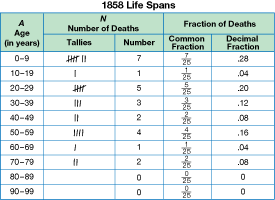Students compare human life span data from 1858 to life span data from 2014. Students organize each data set into groups or bins to compare and analyze the data. Students then use fractions and graphs to describe and compare the different age groups represented in the data. This lesson prepares students for the Live Soap Bubbles lab in Lesson 6.
Content in this Lesson
- Using fractions and decimals to represent the same quantity [E1].
- Comparing fractions and decimals [E3].
- Grouping data into bins to see patterns.
- Using data tables and graphs to organize and display data involving decimal values [E10].
- Making bar graphs using binned data [E10].
- Finding the median of a data set [E11].
- Estimating sums [E9].
- Describing a data set represented in a graph and data table [E11].
- Connecting mathematics to real-world situations.
- Translating between graphs and real-world situations.
- Apply relationships and patterns to solve problems and make predictions [E12].
Assessment in this Lesson
| Assessment | Expectation Assessed |
|---|---|
|
Life Spans |
|














